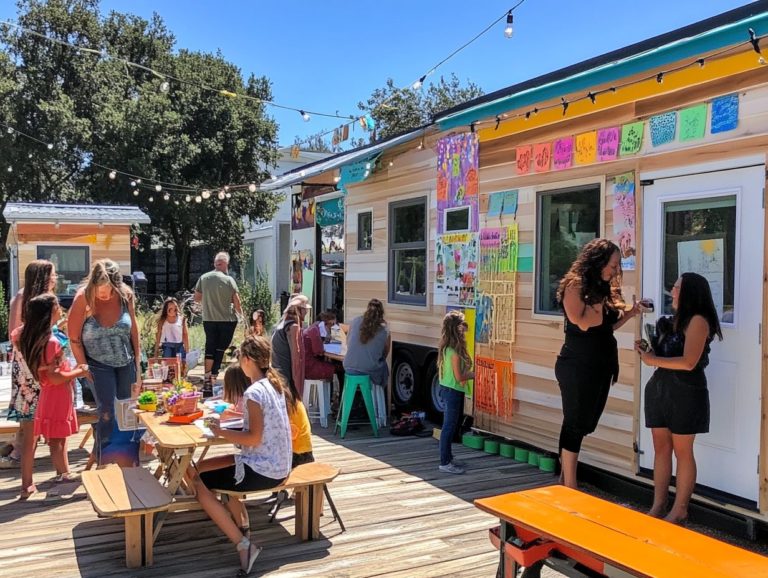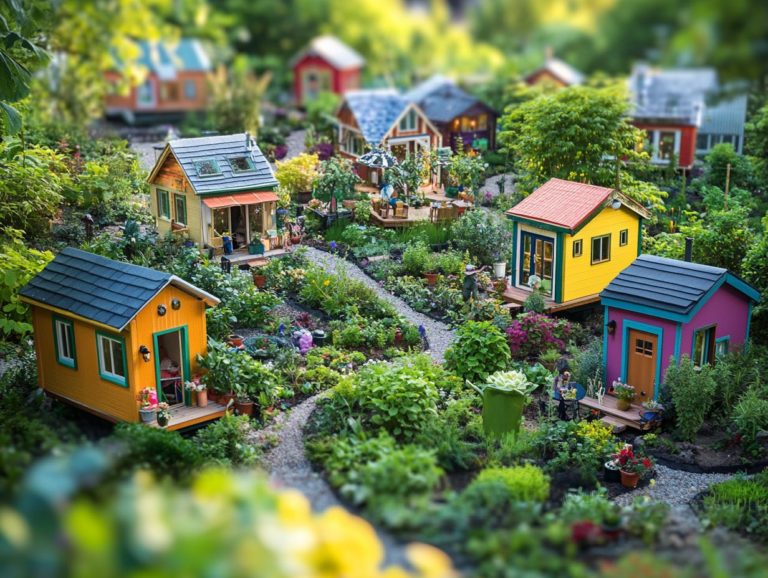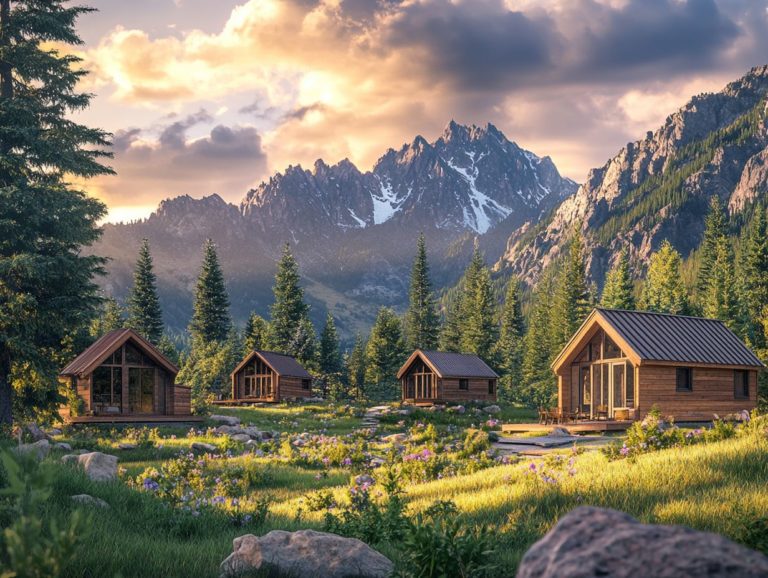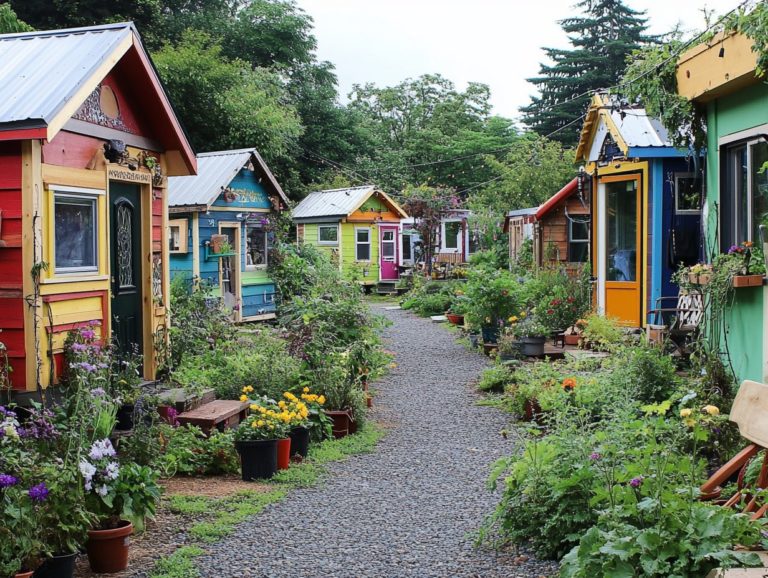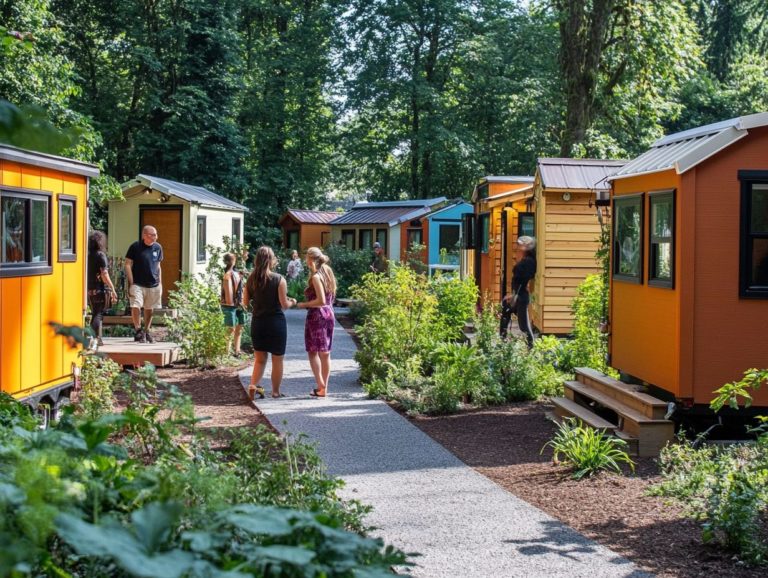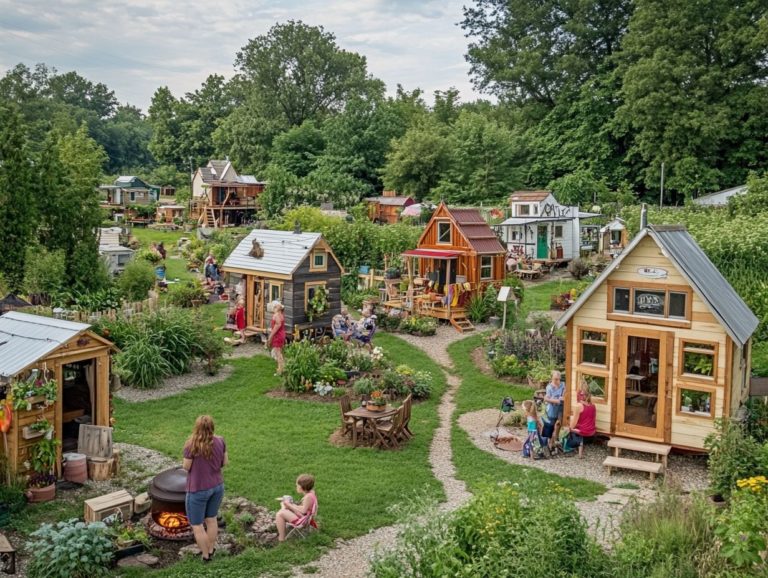Creating a Tiny House Community from Scratch
Tiny house communities are rapidly becoming the go-to choice for those like you who crave a simpler, more sustainable lifestyle. These distinctive living arrangements not only promote minimalism but also cultivate strong bonds among residents.
This exploration delves into the essentials of tiny house communities, highlighting their benefits, practical planning steps, and the intricacies of community living. It also confronts the challenges that may surface and offers valuable insights on creating a harmonious and sustainable environment.
Start your exciting journey to build a vibrant tiny house community today!
Contents [hide]
- Key Takeaways:
- Planning and Building a Tiny House Community
- Community Living in a Tiny House Community
- Challenges and Solutions in Creating a Tiny House Community
- Frequently Asked Questions
- What is a tiny house community?
- Why would someone want to create a tiny house community from scratch?
- What are the key things to consider when creating a tiny house community from scratch?
- Do I need to have experience in construction to create a tiny house community from scratch?
- How can I finance a tiny house community from scratch?
- What are some benefits of living in a tiny house community?
Key Takeaways:
- Living in a tiny house community saves money and builds connections, making life simpler and more fulfilling.
- Successful planning and building of a tiny house community requires careful consideration of land, zoning regulations, and building infrastructure.
- Create a harmonious and sustainable tiny house community by establishing community rules, sharing resources, and working together to overcome challenges.
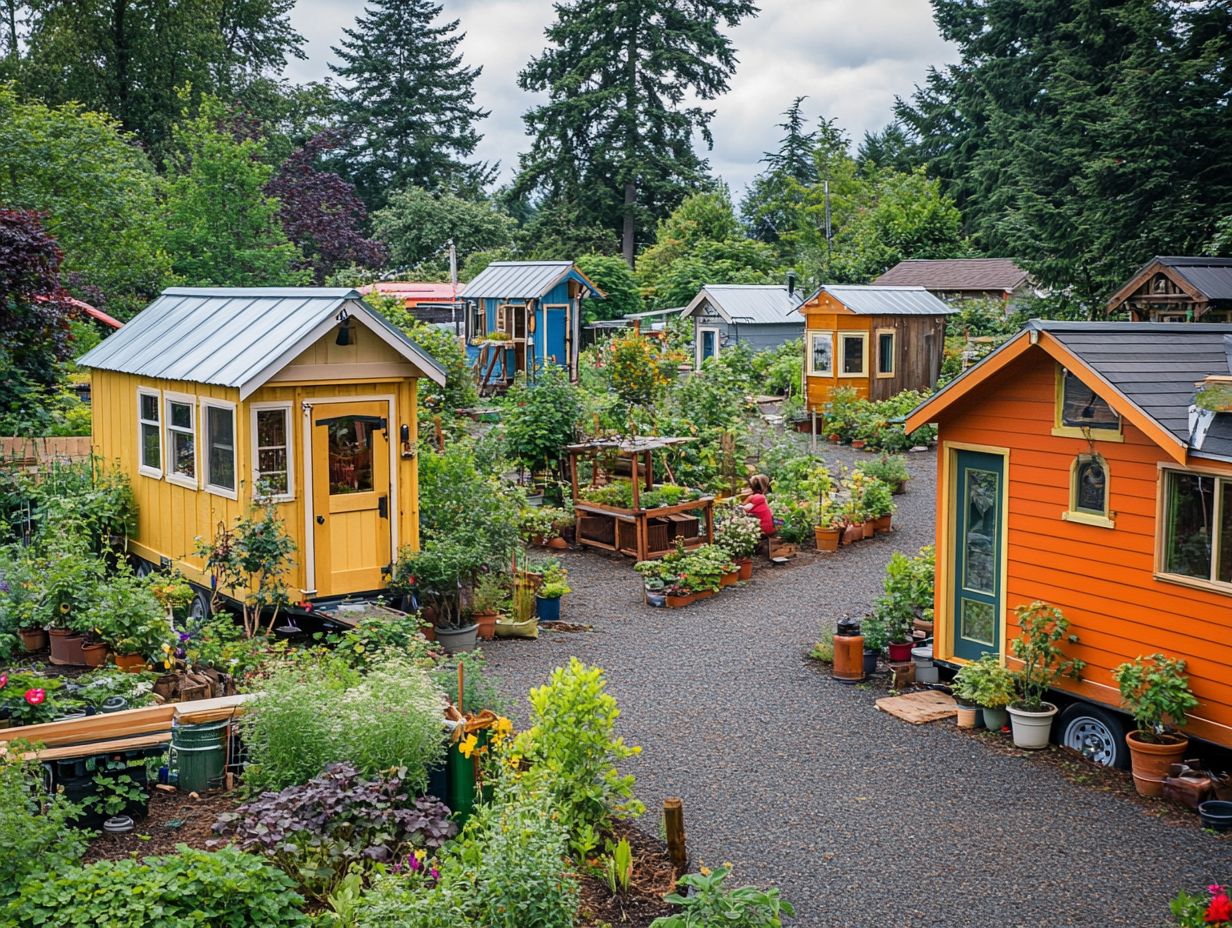
Understanding Tiny House Communities
Tiny House Communities offer you a distinctive way of living that nurtures belonging and sustainability. These eco-conscious living arrangements emphasize sharing life with others, affordability, and a joint commitment to sustainable practices, making them an appealing alternative in states like Florida, Oregon, Texas, and California especially for individuals navigating today s housing crisis.
Inspired by visionaries like Ryan and Elon Musk, these communities often showcase eco-friendly designs and building materials that comply with local building codes and zoning regulations.
Beyond their compact and efficient living spaces which range from minimalist designs to luxurious tiny homes on wheels these communities thrive on our natural desire to connect.
Residents engage in community bonding activities such as potlucks, skill-sharing workshops, and gardening sessions, creating a supportive atmosphere. With a focus on collaboration, tiny house neighborhoods cultivate a unique social culture that prioritizes sustainability and resource-sharing, similar to unique tiny house communities around the world.
This not only strengthens friendships but also encourages the exchange of skills and supplies, fostering a cohesive and environmentally-conscious lifestyle. The sustainable building codes governing these developments ensure they meet safety standards while championing green living principles.
Benefits of Living in a Tiny House Community
Living in a Tiny House Community presents a wealth of benefits that go beyond mere affordability; it opens the door to financial freedom and fosters meaningful connections among its members. With a reduced cost of living, you can allocate resources toward shared spaces and communal activities, embracing a lifestyle that prioritizes sustainability and a deep connection with nature.
By sharing resources, you gain access to amenities and utilities that might otherwise be out of reach, significantly enhancing your quality of life. The sense of belonging in these communities is enriched through regular neighborhood potlucks, where networking and friendships flourish.
You ll often find residents sharing tools, appliances, and skills, which not only cuts down on expenses but also reinforces a culture of mutual aid. If you downsize your living arrangements, you might even enjoy potential tax breaks, further lightening your financial load.
Together, these elements don t just create a sustainable living experience; they cultivate a more fulfilling lifestyle, where bonds are strengthened, and resources are maximized.
Planning and Building a Tiny House Community
Planning and building a Tiny House Community is a multifaceted endeavor that demands your careful attention to legal steps, building codes (rules for how homes should be built), and zoning requirements to ensure compliance with local regulations.
Selecting a suitable location is crucial. It impacts both the logistical aspects of construction and the potential for community engagement and project funding.
In this venture, using tiny home kits can significantly streamline the construction process. Securing investor support will provide the essential financial backing needed to turn your vision into reality, ultimately contributing to the housing options available amid the ongoing housing crisis.
Identifying Land and Zoning Regulations
Identifying land that meets the zoning requirements is essential for establishing a Tiny House Community. This will determine not only the legal framework of your community but also its long-term viability.
Understanding local building codes is crucial and can make or break your community’s success! It involves knowing residential zoning regulations to ensure that the land can be developed as intended, whether you re envisioning tiny houses or RV parks. Thorough research is essential and may require engaging with local authorities to effectively navigate the legal landscape.
In states like Florida, Oregon, Texas, and California, various zoning regulations can greatly impact the development process. Each state has its own distinct guidelines that dictate land use, including minimum lot sizes, density allowances, and the types of structures permitted.
Start your research by focusing on local government websites and participating in community meetings to gather pertinent information. Building rapport with local officials can provide valuable insights into nuances that may not be readily available online.
While these steps can help streamline the process, navigating legal requirements can present challenges, such as dealing with restrictive covenants or the need for property variances. This underscores the importance of being well-informed and prepared for what lies ahead.
Designing the Community Layout
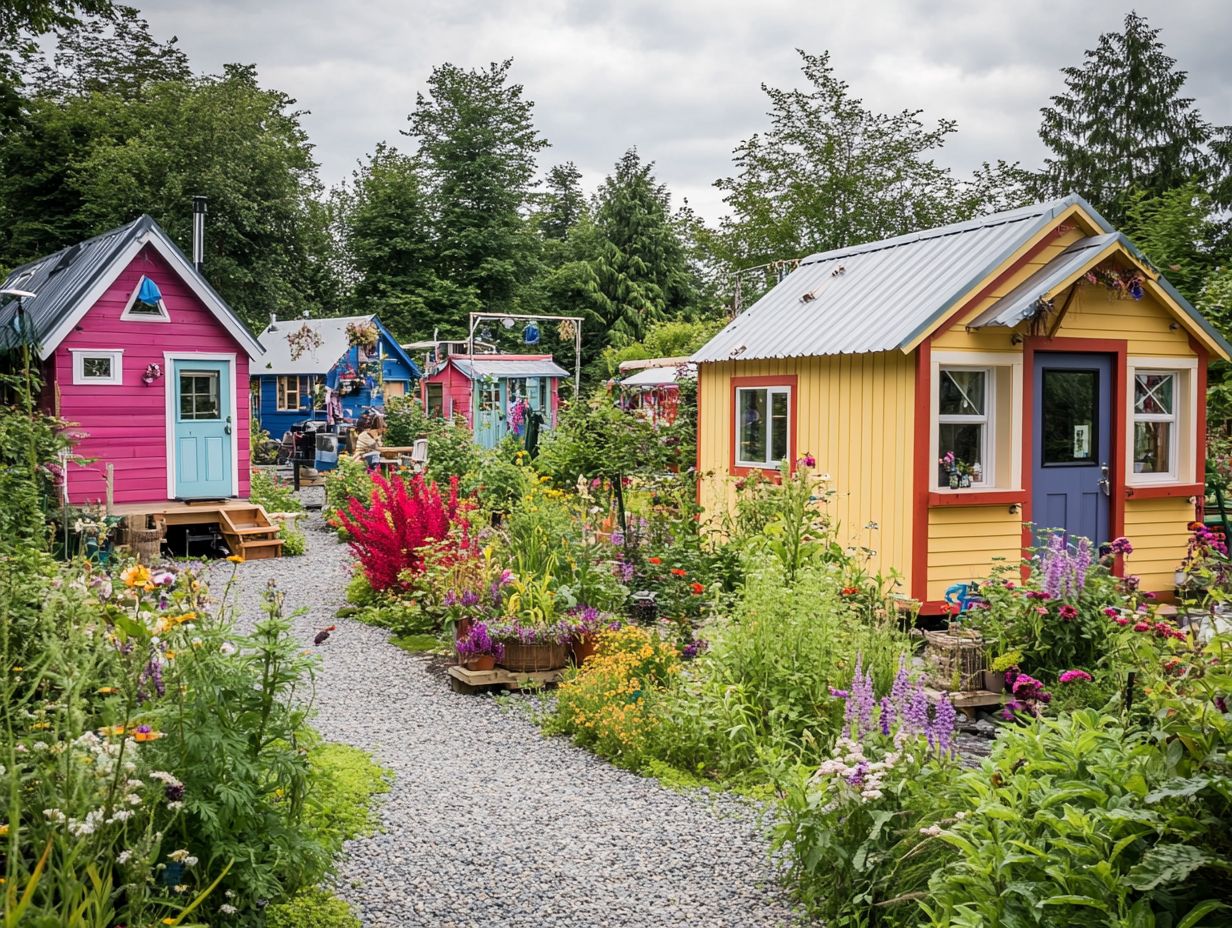
Designing the layout of a Tiny House Community requires you to create a blueprint that seamlessly weaves together tiny home kits, communal spaces, and outdoor areas for various activities, all while fostering a collaborative atmosphere among residents.
This thoughtful design not only maximizes the land but also highlights the significance of community connectivity. By incorporating features like shared gardens, picnic areas, and fire pits, you encourage residents to engage in casual gatherings, helping to build relationships and enhancing their sense of belonging.
Take the layout of the ‘Tiny House Village’ in Oregon as an example. Its clustered home arrangements provide easy access to communal kitchens and recreational spaces. These elements enrich daily life with ample opportunities for outdoor activities and play a crucial role in nurturing lasting friendships, all while promoting a culture of collaboration and support within the community. If you’re interested in constructing a sustainable living space, consider creating an eco-friendly tiny home with local materials.
Imagine the joy of building a community that feels like home! If you’re interested in eco-friendly options, consider designing a tiny house for sustainability. Ready to build your dream Tiny House Community? Let’s get started!
Building and Infrastructure Considerations
When constructing a Tiny House Community, keep in mind various building and infrastructure considerations, such as setting up utilities and the types of materials you choose. The selection of tiny house kits can significantly influence the construction process, offering an efficient means to create quality homes that align with community standards.
Embracing communal living means integrating shared facilities, which can elevate residents’ quality of life and foster building new friendships.
These shared spaces often include communal kitchens, laundry facilities, and recreational areas. It is essential to meticulously plan their locations and utility connections. Proper installation of electrical and water systems is vital, allowing each home to function independently while also supporting communal amenities. For those interested in community living, exploring the top tiny house communities in the USA can provide inspiration. Opting for eco-friendly building materials promotes sustainability and minimizes environmental impact, resonating with many tiny house enthusiasts.
The construction process should encourage collaboration among residents, creating bonds within the community while addressing collective infrastructure needs. To enhance this experience, understanding how to choose the right tiny house community is essential. A thoughtfully crafted approach to these elements can pave the way for a thriving and harmonious living environment.
Community Living in a Tiny House Community
Living in a Tiny House Community centers around well-defined rules and shared resources, fostering a vibrant social culture that enhances your connections with fellow residents. Participating in activities like neighborhood potlucks nurtures a sense of belonging and encourages meaningful interactions within these close-knit neighborhoods.
This collaborative atmosphere gives you the power to take an active role in decision-making processes, fortifying relationships and promoting a culture of support and sustainability.
Community Rules and Regulations
Establishing community rules and regulations is essential for the seamless operation of a Tiny House Community. These guidelines pave the way for harmonious living and positive social interactions among members. These rules address shared responsibilities, noise control, and upkeep of communal spaces, fostering a collaborative environment where everyone can thrive while adhering to a cohesive legal framework.
Your regulations might encompass pet policies, waste management practices, and guidelines for using communal facilities, ensuring that all residents feel respected and valued. By addressing specific needs like designated quiet hours or restrictions on alterations to homes you can tailor the rules to reflect the lifestyle and preferences of the community.
The adaptability of these regulations is crucial. Encouraging input from members fosters a sense of ownership in the governance of the community and enhances cooperation, strengthening bonds among neighbors.
Shared Resources and Responsibilities
Shared resources and responsibilities are the cornerstone of communal living in a Tiny House Community. They not only lower your individual costs but also elevate the overall quality of life for everyone involved. By pooling resources, you gain access to utilities, communal spaces, and outdoor activities that encourage engagement and foster a genuine sense of belonging. This collective approach gives you the power to attain financial freedom while forging lasting social connections.
Consider community gardens they become vibrant hubs where you and your neighbors can collaborate in cultivating fresh produce, leading to healthier diets and a shared passion for gardening. Tool libraries provide a variety of equipment for home improvement or maintenance, saving you both the expense and the storage space needed for personal tools. Shared utilities, like water and energy sources, simplify usage and promote responsible consumption.
These shared resources lighten your burden and build teamwork among residents. This camaraderie fosters deeper relationships and a spirit of cooperation, enriching your daily life in ways you might not have imagined.
Challenges and Solutions in Creating a Tiny House Community
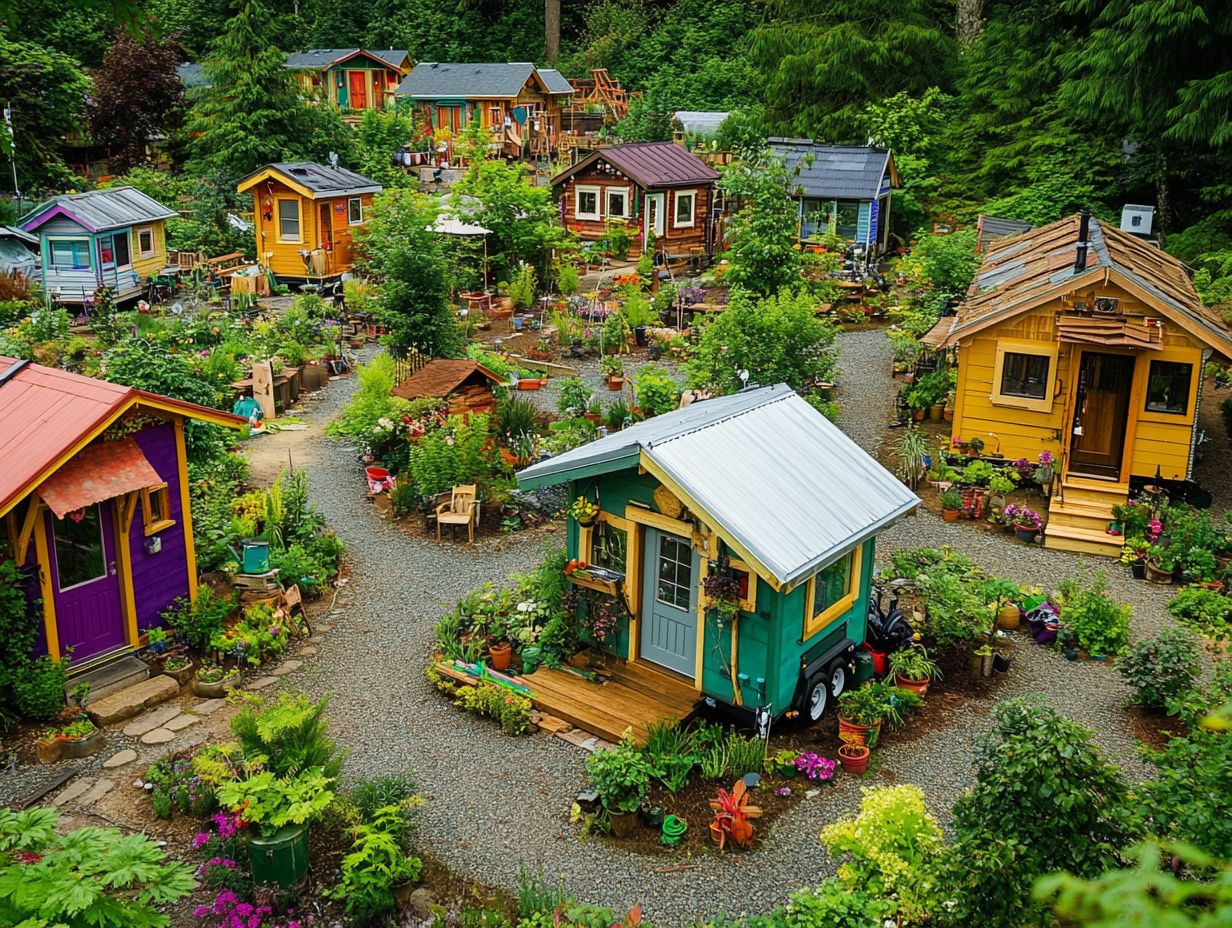
Creating a Tiny House Community comes with its fair share of challenges, especially amid the ongoing housing crisis. However, effective solutions can help you navigate these obstacles with confidence.
Engaging the community is crucial for tackling legal steps and addressing local building rules efficiently. Fostering strong social connections among residents paves the way for smoother collaboration during the construction phase.
Identifying potential roadblocks early can significantly boost your chances for success and sustainability in this endeavor.
Overcoming Obstacles and Roadblocks
Overcoming obstacles and roadblocks is essential for successfully establishing a Tiny House Community. It requires careful attention to legal steps and proactive engagement with the community.
Addressing potential challenges early like securing investor support and navigating local building rules can streamline the process and cultivate a collaborative spirit among community members.
Building a Tiny House Community often means tackling financial constraints alongside resistance from local governments and neighbors who may have misconceptions about this lifestyle. To counteract this, fostering transparent communication and actively involving local stakeholders in the planning stages can prove immensely beneficial. Additionally, consider designing a tiny house for urban living to maximize space and address community concerns.
Organizing workshops or open forums gives residents a platform to voice their concerns and share insights. This fosters a sense of ownership in the project. By demonstrating the importance of sustainability in tiny house communities, you can shift perceptions and garner much-needed support. Sign up for our next workshop to get involved!
Embracing collaboration and harnessing community input can transform hurdles into stepping stones toward a successful and harmonious living environment.
Maintaining Harmony and Sustainability
Maintaining harmony and sustainability within your Tiny House Community requires ongoing effort and commitment. Focus on community engagement and the cultivation of social connections.
Implementing environmental practices and organizing regular communal activities fosters a strong sense of belonging. Open communication among residents will help address any issues that arise, creating a collaborative atmosphere essential for the community’s long-term viability, much like the benefits of living in a tiny house community.
To strengthen these principles, consider organizing regular meetings as a platform for sharing ideas and concerns. This enhances connections among neighbors. Engaging in community service projects beautifies shared spaces and instills a sense of pride and responsibility in everyone involved.
Incorporating environmental initiatives, such as group gardening or recycling drives, encourages sustainable practices while teaching the benefits and joy of eco-conscious living.
Together, these efforts create an environment where cooperation thrives, ultimately nurturing a vibrant community built on mutual respect and shared values.
Frequently Asked Questions
What is a tiny house community?
A tiny house community is a planned neighborhood made up of small, often portable homes. These communities aim to promote sustainable living, simplicity, and community collaboration.
Why would someone want to create a tiny house community from scratch?
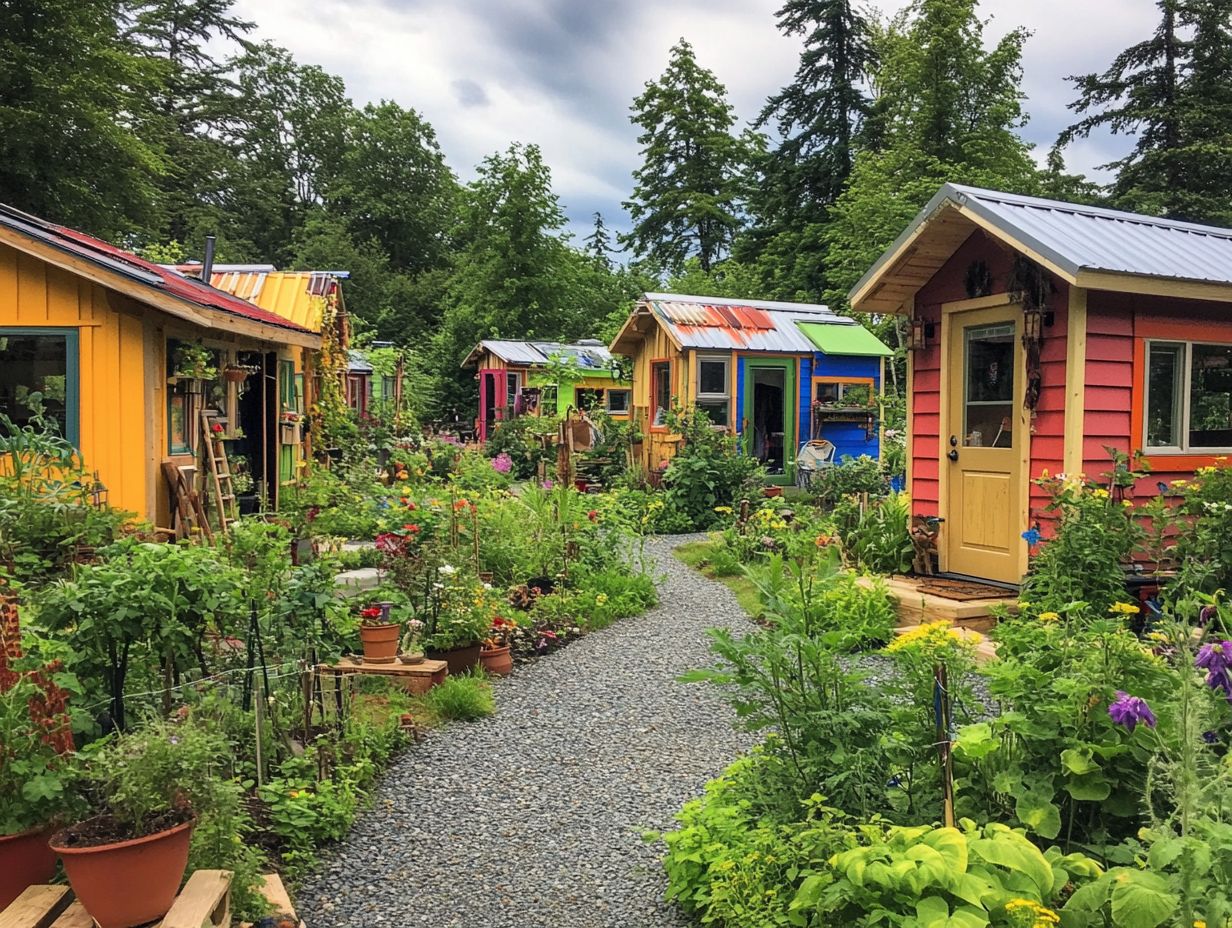
Creating a tiny house community from scratch allows individuals to design and build a community tailored to their specific needs and values. It also provides a sense of ownership and community involvement in the development process.
What are the key things to consider when creating a tiny house community from scratch?
- Location
- Zoning laws and regulations
- Infrastructure
- Community rules and guidelines
- The overall vision for the community
Do I need to have experience in construction to create a tiny house community from scratch?
Construction knowledge is helpful but not essential. You can create a tiny house community without prior experience by collaborating and hiring professionals.
How can I finance a tiny house community from scratch?
You can finance a tiny house community through crowdfunding, loans, or partnerships. Be sure to have a solid financial plan in place.
What are some benefits of living in a tiny house community?
Living in a tiny house community provides many benefits. These include lower living expenses, a strong sense of community, and environmentally friendly living.
Imagine enjoying a cozy, custom-built home while saving money and living more sustainably. You also get the chance to design your home, promoting a simpler lifestyle.

